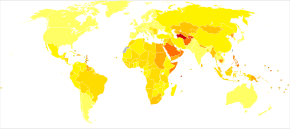Hypertensive heart disease
| Hypertensive heart disease | |
|---|---|
diastolic blood pressure 99 mmHg and heart rate of 80 beats per minute) | |
| Specialty | Cardiology |
Hypertensive heart disease includes a number of complications of high blood pressure that affect the heart. While there are several definitions of hypertensive heart disease in the medical literature,[1][2][3] the term is most widely used in the context of the International Classification of Diseases (ICD) coding categories. The definition includes heart failure and other cardiac complications of hypertension when a causal relationship between the heart disease and hypertension is stated or implied on the death certificate. In 2013 hypertensive heart disease resulted in 1.07 million deaths as compared with 630,000 deaths in 1990.[4]
According to ICD-10, hypertensive heart disease (I11), and its subcategories: hypertensive heart disease with heart failure (I11.0) and hypertensive heart disease without heart failure (I11.9) are distinguished from chronic
Signs and symptoms
The symptoms and signs of hypertensive heart disease will depend on whether or not it is accompanied by heart failure. In the absence of heart failure, hypertension, with or without enlargement of the heart (left ventricular hypertrophy) is usually symptomless.[citation needed]
Symptoms, signs and consequences of
- Fatigue
- Irregular pulse or palpitations
- Swelling of feet and ankles
- Weight gain
- Nausea
- Shortness of breath
- Difficulty sleeping flat in bed (orthopnea)
- Bloating and abdominal pain
- Greater need to urinateat night
- An enlarged heart (cardiomegaly)
- Left ventricular hypertrophy and left ventricular remodeling[5]
- Diminished myocardial ischemia[5]
- Coronary heart disease and accelerated atherosclerosis[5]
- Heart failure with normal left ventricular ejection fraction (HFNEF),diastolic heart failure[5]
- sudden cardiac death[5]
Heart failure can develop insidiously over time or patients can present acutely with acute heart failure or
Diagnosis
| Category | Systolic BP (mm Hg) | Diastolic BP (mm Hg) |
|---|---|---|
| Normal | < 120 | < 80 |
| Elevated | 120–129 and | <80 |
| Stage I | 130–139 or | 80–89 |
| Stage II | at least 140 or | at least 90 |
Differential diagnosis
Other conditions can share features with hypertensive heart disease and need to be considered in the differential diagnosis. For example:[citation needed]
- ischemic heart diseasesdue to atherosclerosis
- Hypertrophic cardiomyopathy
- Left ventricular hypertrophy in athletes
- Congestive heart failureor heart failure with normal ejection fraction due to other causes
- Atrial fibrillation or other disorders of cardiac rhythm due to other causes
- Sleep apnea
Prevention
Because there are no symptoms with high blood pressure, people can have the condition without knowing it. Diagnosing high blood pressure early can help prevent heart disease, stroke, eye problems, and chronic kidney disease.[8]
The risk of cardiovascular disease and death can be reduced by lifestyle modifications, including dietary advice, promotion of weight loss and regular aerobic exercise, moderation of alcohol intake and cessation of smoking.
Blood pressure goals
According to JNC 7, BP goals should be as follows:[7]
- Less than 140/90mm Hg in patients with uncomplicated hypertension
- Less than 130/85mm Hg in patients with diabetes and those with renal disease with less than 1g/24-hour proteinuria
- Less than 125/75mm Hg in patients with renal disease and more than 1 g/24-hour proteinuria
Treatment
The medical care of patients with hypertensive heart disease falls under 2 categories—[13]
- Treatment of hypertension
- Prevention (and, if present, treatment) of heart failure or other cardiovascular disease
Epidemiology


Hypertension or high blood pressure affects at least 26.4% of the world's population.
Sex differences
There are more women than men with hypertension,[19] and, although men develop hypertension earlier in life,[20] hypertension in women is less well controlled.[21][22] The consequences of high blood pressure in women are a major public health problem and hypertension is a more important contributory factor in heart attacks in women than men.[20] Until recently women have been under-represented in clinical trials in hypertension and heart failure. Nevertheless, there is some evidence that the effectiveness of antihypertensive drugs differs between men and women[20] and that treatment for heart failure may be less effective in women.[23]
Ethnic differences
Studies in the US indicate that a disproportionate number of African Americans have hypertension compared with non-Hispanic whites and Mexican Americans, and that they have a greater burden of hypertensive heart disease.[24] Heart failure is more common in people of African American ethnicity, mortality from heart failure is also consistently higher than in white patients, and it develops at an earlier age.[23][25] Recent data suggests that rates of hypertension are increasing more rapidly in African Americans than other ethnic groups.[26] The excess of high blood pressure and its consequences in African Americans is likely to contribute to their shorter life expectancy compared with white Americans.[24]
References
- S2CID 29897347.
- PMID 11032692.
- ^ Gonzalez-Maqueda, I; Alegria-Ezquerra, Eduardo; Gonzalez-Juanatey, Jose Ramon; Working group of the Spanish Society of Cardiology (2009). "Hypertensive heart disease: a new clinical classification (VIA)". e-Journal of the European Society of Cardiology Council for Cardiology Practice. 7 (20): ePub.
- PMID 25530442.)
{{cite journal}}:|first1=has generic name (help)CS1 maint: numeric names: authors list (link - ^ S2CID 38947800.
- PMID 19281919.
- ^ PMID 12748199. Retrieved 17 February 2013.
- ^ "Hypertensive heart disease". Medline Plus. Retrieved 17 February 2013.
- PMID 19324966.
- PMID 21392637.
- S2CID 31212856.
- S2CID 43285809.
- ^ Riaz, Kamran. "Hypertensive Heart Disease". Medscape Reference. Retrieved 17 February 2013.
- ^ a b "WHO Disease and injury country estimates". World Health Organization. 2009. Retrieved Nov 11, 2009.
- S2CID 7244386.
- PMID 1301257.
- PMID 12793706.
- ISBN 978-92-4-156371-0.
- S2CID 24840738.
- ^ PMID 18548147.
- PMID 16046653.
- PMID 11082143.
- ^ PMID 21060326.
- ^ S2CID 11034242.
- PMID 18359324.
- PMID 19075105.
